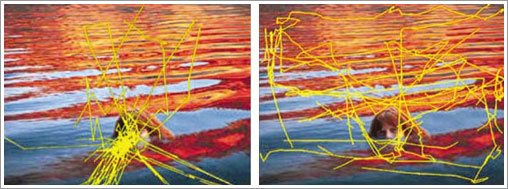Eye tracking technology now allows us to create “heat maps” of visual spaces. It’s of particular use to those of us with an interest in website layout and navigation. The image above is from a recent study that compares the markedly different ways that psychologists (left) and artists (right) look at photographs:
So why do artists look at pictures — especially non-abstract pictures — differently from non-artists? Vogt and Magnussen argue that it comes down to training: artists have learned to identify the real details of a picture, not just the ones that are immediately most salient to the perceptual system, which is naturally disposed to focusing on objects and faces.
Related:
The main problem with narrative in film is that when you become emotionally involved, it becomes difficult to see picture as picture. Of course, the laughing and crying and suspense can be a positive element, but it’s oddly nonvisual and gradually destroys your capacity to see.
— Michael Snow, speaking to Scott MacDonald, A Critical Cinema, Vol. 2
